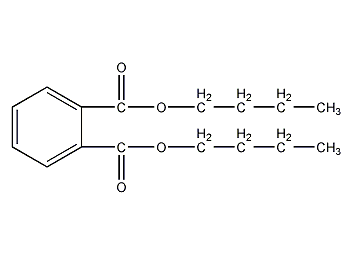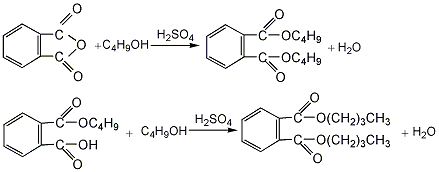
Structural formula
| Business number | 01V1 |
|---|---|
| Molecular formula | C16H22O4 |
| Molecular weight | 278.34 |
| label |
DBP, plasticizer, Lubricants for fabrics, fragrance solvent, pest repellent, adhesive |
Numbering system
CAS number:84-74-2
MDL number:MFCD00009441
EINECS number:201-557-4
RTECS number:TI0875000
BRN number:1914064
PubChem number:24872099
Physical property data
1. Properties: Colorless and transparent oily liquid with slightly aromatic odor.
2. Boiling point (ºC, 101.3kPa): 340
3. Melting point (ºC): -35
4. Relative density (g/mL, 20/4ºC): 1.0465
5. Relative vapor density (g/mL, air=1): 9.6
6. Refractive index (20ºC): 1.4911
7. Viscosity (mPa·s, 37.8ºC): 9.72
8. Flash point (ºC, open): 171.4
9. Flash point (ºC, closed): 157
10. Ignition point (ºC): 403
11. Heat of evaporation (KJ/mol): 79.3
12. Heat of formation (KJ/mol, Liquid): 1025.7
13. Heat of combustion (KJ/mol, liquid, constant pressure): 8616.4
14. Specific heat capacity (KJ/(kg·K), 21ºC, constant pressure ): 1.79
15. Conductivity (S/m, 25ºC): 9×10-11
16. Vapor pressure (kPa, 148.2ºC ): 0.13
17. Solubility: Soluble in common organic solvents and hydrocarbons; solubility in water at 25°C is 0.03%, and water solubility in this product is 0.4%. Easily soluble in alcohol, ether, acetone and benzene.
18. Relative density (25℃, 4℃): 1.0426
19. Refractive index at room temperature (n25): 1.4905
20. Solubility parameter (J·cm-3)0.5: 18.984
21. van der Waals area (cm2 ·mol-1): 2.116×1010
22. van der Waals volume (cm3·mol-1): 160.840
23. Gas phase standard combustion heat (enthalpy) (kJ·mol-1): -8689.3
24. Gas phase standard claimed heat (enthalpy) (kJ·mol-1): -750.9
25. Liquid phase standard combustion heat (enthalpy) (kJ ·mol-1): -8597.7
26. Liquid phase standard claims heat (enthalpy) (kJ·mol-1): -842.6
27. Liquid phase standard hot melt (J·mol-1·K-1): 476.0
<h2Right, add 5% soda ash solution to neutralize, stir for 0.5h, let stand for 1h, and separate the water layer. The crude ester is then washed with hot water at 70-80°C. Then carry out vacuum distillation to recover butanol. When the pressure is 7.9Pa and the temperature is about 150°C, the flash point of the crude ester reaches above 160°C, and dealcoholization is completed. Then use direct steam to blow out the low boiling matter and filter it through a plate and frame filter press to obtain the finished product.
2. Refining method: Contains free acids, alcohols, monobutyl phthalate and other impurities. During refining, wash with water to remove alcohol and acid, then wash with dilute sodium hydroxide solution to remove monobutyl phthalate, then dry with anhydrous potassium carbonate or sodium sulfate, and distill under reduced pressure.

3. Tobacco: 56; OR ,57;BU,14;FC,BU,OR,18.
Purpose
1. This product is a plasticizer. It has strong solubility for a variety of resins. Mainly used in PVC processing, it can give products good softness. Because it is relatively cheap and easy to process, it is widely used in China, almost equivalent to DOP. However, it is highly volatile and water-extractable, so the durability of the product is poor, and its use should be gradually restricted. This product is an excellent plasticizer of nitrocellulose and has strong gelling ability. Used in nitrocellulose coatings, it has a good softening effect. Excellent stability, flex resistance, adhesion and water resistance. In addition, this product can also be used as a plasticizer for polyvinyl acetate, alkyd resin, ethyl cellulose and chloroprene rubber. It can also be used to make paints, adhesives, artificial leather, printing inks, safety glass, celluloid, and dyes. , pesticides, fragrance solvents, fabric lubricants, etc.
2. This product is the most commonly used important plasticizer for polyvinyl chloride. It can make the products have good softness, but it has high volatility and water extraction, so the durability of the products is poor. This product is an excellent plasticizer for nitrocellulose and has strong gelling ability. Used in nitrocellulose coatings, it has good softening effect, and its stability, flex resistance, adhesion and waterproofness are better than other plasticizers. This product can also be used as a plasticizer for polyvinyl acetate, alkyd resin, nitrocellulose, ethylcellulose, chloroprene rubber, and nitrile rubber.


